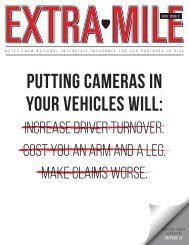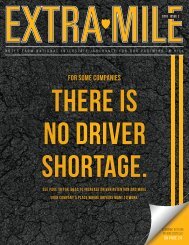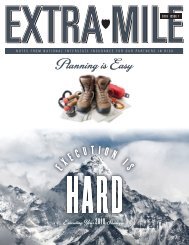ExtraMileIssue9
Create successful ePaper yourself
Turn your PDF publications into a flip-book with our unique Google optimized e-Paper software.
CAM 1_<br />
CAM 2_<br />
CAM 3_<br />
CAM 4_<br />
CAM 5_<br />
CAM 6_<br />
PREPARE FOR SNOW AND ICE REMOVAL<br />
Slips, trips and falls are already a significant concern for most<br />
transportation companies, often topping the list of their<br />
workers’ compensation cause of injury reports. These injuries<br />
naturally increase for those impacted by colder weather with the<br />
added challenge of accumulating snow and ice patches throughout<br />
uncovered workspaces.<br />
Tips for Reducing Ice and Snow-related Injuries:<br />
➼ Remind employees to shuffle their feet when walking through<br />
the parking area, yard or other uncovered workspaces. This will<br />
help avoid a fall on the ice by keeping feet in contact with the<br />
ground at all times, and not directly placing one’s foot down<br />
on unseen ice.<br />
➼ Consider purchasing snow<br />
cleats for your drivers and other<br />
employees who travel through<br />
such uncovered spaces. The most<br />
common reason employees do not<br />
wear cleats when provided is that they should be removed<br />
when entering a vehicle in order to not create damage.<br />
Therefore, look for brands that will not cause damage to<br />
the vehicle and do not need to be removed, such as the pair<br />
below. This will assist with employee adoption and utilization<br />
rates on your investment.<br />
➼ Consider a snow and ice detection sign<br />
for your yard like this one. This additional<br />
warning signage will not only act as a<br />
reminder to employees re-entering the<br />
space to use caution, but will identify the precise conditions<br />
they should prepare for.<br />
➼ Additional signage should be posted in breakrooms and around<br />
the office and garage. This is common for any safety warning<br />
or announcement, but still remains effective. Regular attention<br />
to a risk will make it more prevalent in employees’ minds and<br />
more likely to be considered.<br />
New OSHA Walking Workspace Update includes Snow and Ice Removal<br />
Not only should you focus on snow and ice removal for the safety<br />
of your employees and to keep your injuries low, you now need to<br />
do so to avoid an OSHA citation and fine. Effective January 17,<br />
2017, OSHA included snow and ice removal to the Walking-Working<br />
Surfaces regulation in order to protect employees from snow- and<br />
ice-related injuries. 1<br />
To stay compliant, create a removal plan that includes:<br />
➼ Designation of more than one person to arrive prior to other<br />
employees and ensure they are capable of snow removal and<br />
laying salt. Always have a back-up employee should the other<br />
be out of work that day.<br />
➼ Proper removal equipment and PPE-like snow cleats for those<br />
persons.<br />
➼ A communication plan for times when accumulation is<br />
inevitable to notify employees re-entering the space of the risky<br />
conditions.<br />
Stay compliant with OSHA and work to mitigate slips, trips and falls<br />
that may lead to costly workers’ compensation claims by following<br />
these simple steps.<br />
CAM 7_<br />
Sources:<br />
1 https://www.osha.gov/pls/oshaweb/owadisp.show_document?p_table=STANDARDS&p_id=9714<br />
KATE MITCHELL<br />
Risk Management Team Leader<br />
26<br />
27
















